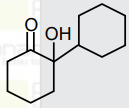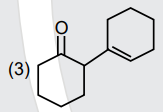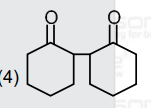Cyclohexylamine when treated with nitrous acid yields (P). On treating (P) with PCC results in (Q). When (Q) is heated with dil. NaOH we get (R) The final product (R) is :




The correct Answer is:B
To solve the given question step by step, we will analyze the reactions involving cyclohexylamine and the reagents mentioned.
Step 1: Identify the structure of Cyclohexylamine
Cyclohexylamine is a six-membered carbon ring with an amine group (-NH2) attached to it. The structure can be represented as follows:
NH2∣C1−C2C6C3 C5−C4
Step 2: Treat Cyclohexylamine with Nitrous Acid (HNO2)
When cyclohexylamine is treated with nitrous acid (HNO2), it undergoes a diazotization reaction. The amine group (-NH2) is converted into a hydroxyl group (-OH), resulting in the formation of cyclohexanol (P).
Reaction:
Cyclohexylamine + HNO2 → Cyclohexanol (P)
Step 3: Treat Cyclohexanol (P) with PCC
Pyridinium chlorochromate (PCC) is a mild oxidizing agent. When cyclohexanol (P) is treated with PCC, it gets oxidized to cyclohexanone (Q), which is a ketone.
Reaction:
Cyclohexanol (P) + PCC → Cyclohexanone (Q)
Step 4: Heat Cyclohexanone (Q) with Dilute NaOH
When cyclohexanone (Q) is heated with dilute sodium hydroxide (NaOH), it can undergo an aldol condensation reaction. However, since we are dealing with a cyclic ketone, it will not undergo aldol condensation in the traditional sense. Instead, it can lead to the formation of a product through a rearrangement or elimination reaction.
In this case, heating cyclohexanone with dilute NaOH can lead to the formation of cyclohexene (R) through dehydration.
Reaction:
Cyclohexanone (Q) + Dilute NaOH (heat) → Cyclohexene (R)
Final Product (R)
The final product (R) is cyclohexene, which is an alkene.
Summary of Reactions:
1. Cyclohexylamine + HNO2 → Cyclohexanol (P)
2. Cyclohexanol (P) + PCC → Cyclohexanone (Q)
3. Cyclohexanone (Q) + Dilute NaOH (heat) → Cyclohexene (R)
Final Answer:
The final product (R) is cyclohexene.
---
Cyclohexylamine is a six-membered carbon ring with an amine group (-NH2) attached to it. The structure can be represented as follows:
When cyclohexylamine is treated with nitrous acid (HNO2), it undergoes a diazotization reaction. The amine group (-NH2) is converted into a hydroxyl group (-OH), resulting in the formation of cyclohexanol (P).
Cyclohexylamine + HNO2 → Cyclohexanol (P)
Pyridinium chlorochromate (PCC) is a mild oxidizing agent. When cyclohexanol (P) is treated with PCC, it gets oxidized to cyclohexanone (Q), which is a ketone.
Cyclohexanol (P) + PCC → Cyclohexanone (Q)
When cyclohexanone (Q) is heated with dilute sodium hydroxide (NaOH), it can undergo an aldol condensation reaction. However, since we are dealing with a cyclic ketone, it will not undergo aldol condensation in the traditional sense. Instead, it can lead to the formation of a product through a rearrangement or elimination reaction.
Cyclohexanone (Q) + Dilute NaOH (heat) → Cyclohexene (R)
The final product (R) is cyclohexene, which is an alkene.
1. Cyclohexylamine + HNO2 → Cyclohexanol (P)
2. Cyclohexanol (P) + PCC → Cyclohexanone (Q)
3. Cyclohexanone (Q) + Dilute NaOH (heat) → Cyclohexene (R)
The final product (R) is cyclohexene.
Topper's Solved these Questions
Similar Questions
Knowledge Check
Diethyl amine when treated with nitrous acid yields
Adiethyl ammonium nitriteBethyl alcoholCN-nitroso diethyl amineDtriethyl ammonium nitriteDiethyl amine when treated with nitros acid yields
Adiethyl alcoholBN nitroso diethyl amineCN nitroso diethyl amneDtriethyl ammonium nitriteDiethyl amine when treated with nitros acid yields
Adiethyl alcoholBN nitroso diethyl amineCN nitroso diethyl amneDtriethyl ammonium nitrite
The amine 'A' when treated with nitrous acid gives yellow oily substance. The amine A is
View SolutionWhen chloroform is treated with amine and KOH, we get
View SolutionWhen chloroform is treated with amine and KOH, we get
View SolutionWhen Zn is treated with excess of NaOH, the product obtained is
View SolutionWhen chloroform is treated with amine and KOH , we get:
View Solution
